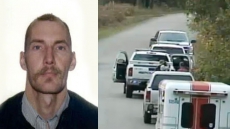VANCOUVER - Don't be afraid of bats this Halloween. Be afraid for them, warn biologists tracking a disease that has nearly wiped out the airborne mammals in Eastern Canada.
The little brown bat, northern myotis and tri-coloured bat have been "functionally extirpated" by white-nose syndrome in some areas of eastern Canada, said Graham Forbes, a biologist at the University of New Brunswick and a member of the Committee on the Status of Endangered Wildlife in Canada subcommittee.
In New Brunswick, it's estimated about 99 per cent of little brown bats have died. Nova Scotia was hit hard last winter and the syndrome has now spread to Cape Breton, Forbes said.
First documented in New York in the winter of 2006, the disease surfaced in Canada in 2010. It has since been confirmed in 25 U.S. states and in Ontario, Quebec, New Brunswick, PEI and Nova Scotia.
It hasn't yet reached Manitoba but has been detected further west every year, Forbes said.
"It's spreading," he said.
"One extra concern is if it jumps across and gets into the western populations. Hopefully that won't happen, but I think I'll be surprised if it doesn't happen."
The disease is caused by a fungus that grows over the bats' faces while they hibernate in winter.
The fungus grows in cold weather, and it hits while bats are most vulnerable, hibernating in caves and old mines through the winter. Experts believe the fungus was introduced in North America by a visitor from Europe, where it has existed for some time and where bats have developed resistance.
The disease has been expanding at an average rate of 200-250 kilometres per year, according to the Canadian Wildlife Health Co-operative.
There is currently no cure or containment for the syndrome, and without one, it is expected that the entire Canadian population of bats will be affected within 12 to 18 years, the group said.
The Committee on the Status of Endangered Wildlife in Canada recommended almost a year ago that the federal environment minister designate the little brown bat, northern myotis and tri-colored bat endangered under the Species at Risk Act.
In an emailed statement, an Environment Canada spokesman declined to say when the minister planned to make a decision about whether to list the bats as endangered.
"Officials continue to gather and assess information with the objective of supporting decisions based on the best information available," wrote Danny Kingsberry.
The statement noted federal, provincial and territorial governments have prepared a national plan to respond to white-nose syndrome, and Environment Canada has provided $330,000 in research funding to the Canadian Wildlife Health Co-operative.
One major hurdle for biologists is the dearth of knowledge about bats. It wasn't until the disease began devastating the species that many realized how little they knew.
In British Columbia, the Wildlife Conservation Society Canada recently completed a survey of bats in the pristine Flathead River valley in southeast corner of the province.
Cori Lausen, a bat specialist with the society, said they are preparing for the disease to breach Manitoba and then the continental divide.
"We have to find our hibernacula to save our bats," she said.
"We know surprisingly little about what our bats do in the winter. Part of the urgency right now is to figure out where they're going in the winter... It's a little bit like finding a needle in a haystack. We've got so much ground to cover."
It's just a matter of time before the syndrome arrives in the West, she said. In B.C., the Flathead River valley is likely the first area it will appear.
The valley is shared with Alberta, which has protected it in the Waterton Lakes national park, and Montana, which has designated Flathead Lake state park.
A recent four-day "bio-blitz" with scientists from the Royal British Columbia Museum found seven species in the valley. Another three are likely to be present, based on acoustic tests, Lausen said.
There is some promising research underway in the U.S., including a study of a naturally occurring bacteria that appears to slow the growth of the fungus.
But recovery will be slow, Forbes said. Bats produce only one offspring per year.
"The time it will take for the population to recover could be many, many years and in the interim some places might go down," he said.
"There might be a few around but they're no longer really part of the ecosystem. We call that functionally extirpated."
Note to readers: This is a corrected story. An earlier version had mistakenly referred to white-nose syndrome as white-noise syndrome in several references.





